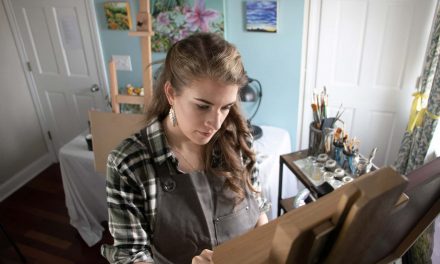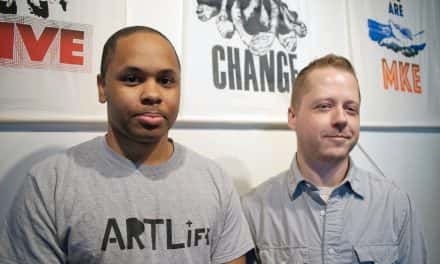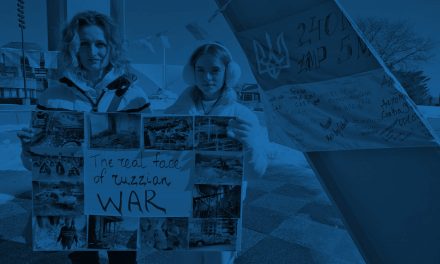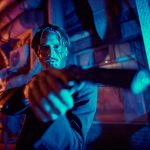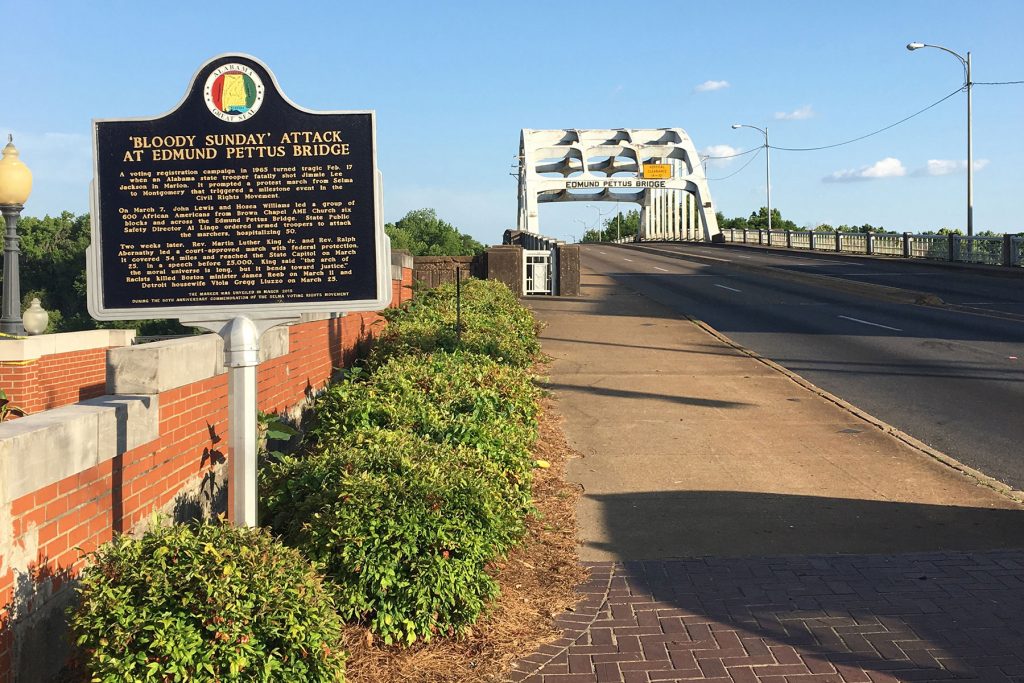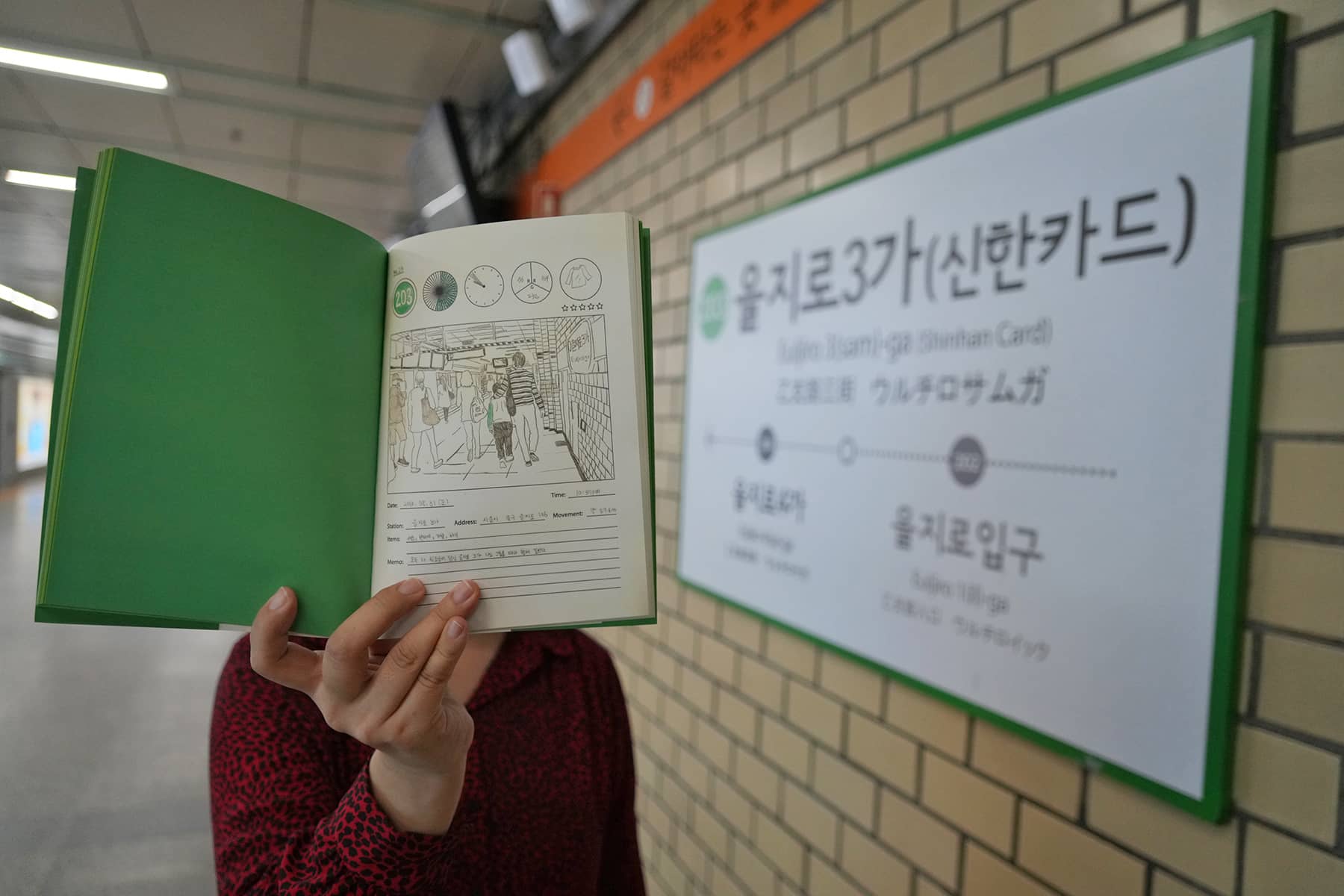
After spending the first of several days at the Demilitarized Zone (DMZ) between North and South Korea, Milwaukee Independent returned to Seoul and encountered renowned artist Jinseon Kim at City Hall, during the public display of her “Seoul Records by a Seoulite” exhibit.
The meeting and interview led to a truly magical opportunity, where Milwaukee Independent spent a day with the artist and followed in the steps of her book “② 호선 부루마블. Get on, Get off, Get green on Subway line 2.”
Combined with her art exhibition “Seoul Records by a Seoulite,” the illustrated book visually captured the vibrant essence of Seoul’s Subway Line 2. Known for its circular route that connects key districts of the city, Line 2 is much more than just a transportation system. It is a cultural artery that reflects the daily lives, histories, and urban pulse of Seoul.
Through Jinseon’s artistic lens, her illustrations brought to life the landmarks and neighborhoods that Line 2 connected. Spending a day on Line 2 provided Milwaukee Independent with a unique social and cultural experience of those spaces by matching Jinseon’s whimsical yet detailed depictions of historical sites and local traditions with the reality of place and identity.
Many stops served as a guide through the physical subway line and the heart of Seoul’s evolving urban landscape, making the visual journey both educational and enriching. This feature combines images taken on that day of exploration by senior photojournalist Lee Matz, and journal entries about the experience written by Jinseon.
PROLOGUE
“We started at Euljiro 3-ga Station, got off at Sports Complex Station, and then returned to Euljiro 3-ga Station. The weather was extremely hot, almost melting us, but our enthusiasm was just as intense as the heat. It was the first time I’ve ever had so many photos taken of me in one day. It was a truly special experience.” – Jinseon Kim
BREAKING DOWN LANGUAGE BARRIERS
“I even get nervous in front of my close friends’ cameras. But this time, since it was our second meeting and there was a language barrier, I was even more nervous than when I am in front of my friends’ cameras. The language barrier was my biggest concern. When we can’t communicate through language, we pay more attention to each other’s expressions. Normally, I get quite stiff in front of the camera. I was very surprised when Lee Matz said he thought I was uncomfortable; that wasn’t the case at all. I think my nervous expression might have led to that misunderstanding. Since I couldn’t express that I was enjoying and participating with words, I suggested some photo ideas to show how I felt through my actions. In fact, even though I might come across as reserved at first, I’m actually quite good at making jokes and having fun once I get to know people. It seems that not being able to communicate in the language made me appear shyer than I am. The disappointment of not being able to explain my work and my thoughts at the exhibition, and not being able to present myself as I truly am, has made me want to study English again.” – Jinseon Kim
THE FIRST TIME I VISITED THE 1988 SEOUL OLYMPIC STADIUM
“When I was young, I went to Jamsil Baseball Stadium to see performances by Korean singers. However, I had never been to the nearby Olympic Stadium until I visited it with Lee for the first time. It was also a special experience. I was very young back then and have no memories of the Olympics, but I know the famous song “Hand in Hand” and the opening ceremony well since they are so famous, and I really like that song. Being at the venue now, I can still feel the thrill of that experience. I view the Olympics as a gathering of people from around the world and a global festival. In that sense, the 1988 Seoul Olympic Stadium and Jamsil are very significant areas and places in Seoul. Going to such an Olympic stadium with an American photojournalist was even more special!” – Jinseon Kim
BACK TO EULJIRO 3-GA
“We returned to Euljiro 3-ga and walked through the Coffee Han-Yak-Bang and the alleys of the Euljiro industrial district together. Coffee Han-Yak-Bang is a place I used to visit often with my close friends, so it was wonderful to go there with Lee and see that he liked it – although he was disappointed that the melon bread was sold out. Even though there was a language barrier while we were exploring together, I enjoyed getting to know each other better and becoming closer. I think that next time we meet, we’ll be able to create even more fun and engaging moments. Lee is truly an excellent creative partner. I’d like to meet again next time, whether in Milwaukee or Seoul.” – Jinseon Kim
EPILOGUE
“In the beginning, we met at Seoul City Hall, the most important administrative center in Seoul. When we met again, we rode Seoul’s Subway Line 2, the only line that travels exclusively within Seoul (along with my Line 2 drawing book). We visited one of Seoul’s most significant places, the 1988 Seoul Olympic Stadium. We also went to a café in Seoul that operates in a historically significant location. In a short time, we explored important places throughout Seoul. Despite the language barrier, we became quite close in a relatively short time through each other’s efforts and consideration. I believe it’s because of the art that connects us, through the exhibition and the photos. Art transcends borders and boundaries, touching and connecting people’s hearts. It was an honor to have shared that experience with Lee.” – Jinseon Kim
- Exploring Korea: Stories from Milwaukee to the DMZ and across a divided peninsula
- A pawn of history: How the Great Power struggle to control Korea set the stage for its civil war
- Names for Korea: The evolution of English words used for its identity from Gojoseon to Daehan Minguk
- SeonJoo So Oh: Living her dream of creating a "folded paper" bridge between Milwaukee and Korean culture
- A Cultural Bridge: Why Milwaukee needs to invest in a Museum that celebrates Korean art and history
- Korean diplomat joins Milwaukee's Korean American community in celebration of 79th Liberation Day
- John T. Chisholm: Standing guard along the volatile Korean DMZ at the end of the Cold War
- Most Dangerous Game: The golf course where U.S. soldiers play surrounded by North Korean snipers
- Triumph and Tragedy: How the 1988 Seoul Olympics became a battleground for Cold War politics
- Dan Odya: The challenges of serving at the Korean Demilitarized Zone during the Vietnam War
- The Korean Demilitarized Zone: A border between peace and war that also cuts across hearts and history
- The Korean DMZ Conflict: A forgotten "Second Chapter" of America's "Forgotten War"
- Dick Cavalco: A life shaped by service but also silence for 65 years about the Korean War
- Overshadowed by conflict: Why the Korean War still struggles for recognition and remembrance
- Wisconsin's Korean War Memorial stands as a timeless tribute to a generation of "forgotten" veterans
- Glenn Dohrmann: The extraordinary journey from an orphaned farm boy to a highly decorated hero
- The fight for Hill 266: Glenn Dohrmann recalls one of the Korean War's most fierce battles
- Frozen in time: Rare photos from a side of the Korean War that most families in Milwaukee never saw
- Jessica Boling: The emotional journey from an American adoption to reclaiming her Korean identity
- A deportation story: When South Korea was forced to confront its adoption industry's history of abuse
- South Korea faces severe population decline amid growing burdens on marriage and parenthood
- Emma Daisy Gertel: Why finding comfort with the "in-between space" as a Korean adoptee is a superpower
- The Soul of Seoul: A photographic look at the dynamic streets and urban layers of a megacity
- The Creation of Hangul: A linguistic masterpiece designed by King Sejong to increase Korean literacy
- Rick Wood: Veteran Milwaukee photojournalist reflects on his rare trip to reclusive North Korea
- Dynastic Rule: Personality cult of Kim Jong Un expands as North Koreans wear his pins to show total loyalty
- South Korea formalizes nuclear deterrent strategy with U.S. as North Korea aims to boost atomic arsenal
- Tea with Jin: A rare conversation with a North Korean defector living a happier life in Seoul
- Journalism and Statecraft: Why it is complicated for foreign press to interview a North Korean defector
- Inside North Korea’s Isolation: A decade of images show rare views of life around Pyongyang
- Karyn Althoff Roelke: How Honor Flights remind Korean War veterans that they are not forgotten
- Letters from North Korea: How Milwaukee County Historical Society preserves stories from war veterans
- A Cold War Secret: Graves discovered of Russian pilots who flew MiG jets for North Korea during Korean War
- Heechang Kang: How a Korean American pastor balances tradition and integration at church
- Faith and Heritage: A Pew Research Center's perspective on Korean American Christians in Milwaukee
- Landmark legal verdict by South Korea's top court opens the door to some rights for same-sex couples
- Kenny Yoo: How the adversities of dyslexia and the war in Afghanistan fueled his success as a photojournalist
- Walking between two worlds: The complex dynamics of code-switching among Korean Americans
- A look back at Kamala Harris in South Korea as U.S. looks ahead to more provocations by North Korea
- Jason S. Yi: Feeling at peace with the duality of being both an American and a Korean in Milwaukee
- The Zainichi experience: Second season of “Pachinko” examines the hardships of ethnic Koreans in Japan
- Shadows of History: South Korea's lingering struggle for justice over "Comfort Women"
- Christopher Michael Doll: An unexpected life in South Korea and its cross-cultural intersections
- Korea in 1895: How UW-Milwaukee's AGSL protects the historic treasures of Kim Jeong-ho and George C. Foulk
- "Ink. Brush. Paper." Exhibit: Korean Sumukhwa art highlights women’s empowerment in Milwaukee
- Christopher Wing: The cultural bonds between Milwaukee and Changwon built by brewing beer
- Halloween Crowd Crush: A solemn remembrance of the Itaewon tragedy after two years of mourning
- Forgotten Victims: How panic and paranoia led to a massacre of refugees at the No Gun Ri Bridge
- Kyoung Ae Cho: How embracing Korean heritage and uniting cultures started with her own name
- Complexities of Identity: When being from North Korea does not mean being North Korean
- A fragile peace: Tensions simmer at DMZ as North Korean soldiers cross into the South multiple times
- Byung-Il Choi: A lifelong dedication to medicine began with the kindness of U.S. soldiers to a child of war
- Restoring Harmony: South Korea's long search to reclaim its identity from Japanese occupation
- Sado gold mine gains UNESCO status after Tokyo pledges to exhibit WWII trauma of Korean laborers
- The Heartbeat of K-Pop: How Tina Melk's passion for Korean music inspired a utopia for others to share
- K-pop Revolution: The Korean cultural phenomenon that captivated a growing audience in Milwaukee
- Artifacts from BTS and LE SSERAFIM featured at Grammy Museum exhibit put K-pop fashion in the spotlight
- Hyunjoo Han: The unconventional path from a Korean village to Milwaukee’s multicultural landscape
- The Battle of Restraint: How nuclear weapons almost redefined warfare on the Korean peninsula
- Rejection of peace: Why North Korea's increasing hostility to the South was inevitable
- WonWoo Chung: Navigating life, faith, and identity between cultures in Milwaukee and Seoul
- Korean Landmarks: A visual tour of heritage sites from the Silla and Joseon Dynasties
- South Korea’s Digital Nomad Visa offers a global gateway for Milwaukee’s young professionals
- Forgotten Gando: Why the autonomous Korean territory within China remains a footnote in history
- A game of maps: How China prepared to steal Korean history to prevent reunification
- From Taiwan to Korea: When Mao Zedong shifted China’s priority amid Soviet and American pressures
- Hoyoon Min: Putting his future on hold in Milwaukee to serve in his homeland's military
- A long journey home: Robert P. Raess laid to rest in Wisconsin after being MIA in Korean War for 70 years
- Existential threats: A cost of living in Seoul comes with being in range of North Korea's artillery
- Jinseon Kim: A Seoulite's creative adventure recording the city’s legacy and allure through art
- A subway journey: Exploring Euljiro in illustrations and by foot on Line 2 with artist Jinseon Kim
- Seoul Searching: Revisiting the first film to explore the experiences of Korean adoptees and diaspora



















































































